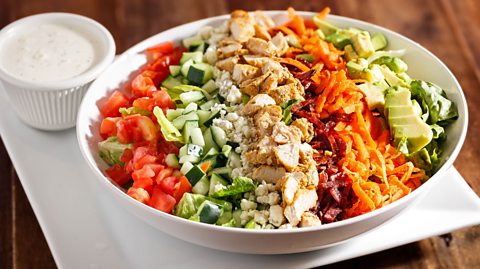Whether itÔÇÖs warm outside, you donÔÇÖt want to eat anything too heavy, or you simply have a load of veg to use up - many of us think salads are simply ace.
If youÔÇÖve ever seen it as something a bit boring on the side of your plate, that you reluctantly finish after everything else, this could be where you see salad afresh.
91╚╚▒Č Bitesize takes a look at the surprising stories behind the salads enjoyed all over the world - some of which you can really get your teeth into.
The salad ni├žoise: A sense of community pride
If youÔÇÖve ever visited the French city of Nice, aside from the bustling seafront and the fascinating sights of the old town, you may have had time to enjoy a homegrown salad ni├žoise.

Salade Ni├žoise, as it's officially called, dates back to the late 19th and early 20th Centuries when the port of Nice saw fishing crews rubbing shoulders with traders and the two distinct groups (eventually) combined ingredients from land and sea to produce the blend of tuna, anchovies, tomatoes, eggs, potato and salad leaves that we know today.
The first known version of the salad ni├žoise was assembled in the 19th Century and contained tomatoes, anchovies and olive oil. As it grew in popularity, more versions appeared as more ingredients were added. It was a 1903 recipe from Henri Hayraud - a chef and teacher writing about NiceÔÇÖs cuisine - which included artichokes, red peppers, black olives, and anchovies - but no tuna. The actual contents of a salad ni├žoise led to much local debate, and still does. Purists would argue that the salad can contain either tuna or anchovies, but not both, and there are differing ideas on whether potatoes should be in there at all.
Regardless of the recipe, or the chefÔÇÖs personal preference when assembling one, the salad ni├žoise continues to be a proud symbol of life in Nice, evoking its sense of community.
The Waldorf salad: A nutty - or not - taste of New York
Inextricably linked with the Waldorf Astoria Hotel in New York, like the Nicoise, the Waldorf Salad has no hard and fast rules over what it should contain. Different cookbooks may contain different recipes for the dish, yet list it under the same name.

The original recipe came from Oscar Tschirky, the Translated as ÔÇśmaster of the houseÔÇÖ the ma├«tre d'h├┤tel is the head of the dining room staff at a restaurant or hotel. of the Waldorf Astoria Hotel in the late 19th Century.
Although Oscar wasnÔÇÖt actually a chef by reputation, he was a well-known figure in New York society, having arrived in New York in 1883, a teenage Swiss immigrant.
The first Waldorf salad was served at a charity ball for a childrenÔÇÖs hospital, held in the hotel in March 1896. This was the same year it appeared in OscarÔÇÖs own cookbook that celebrated the hotel. The original version had just three ingredients; apple, celery and mayonnaise. There was no mention of walnuts, which appear in modern recipes for a Waldorf salad, as do grapes.
Perhaps even more fascinating than the development of the saladÔÇÖs components over time is the story of the man who made it famous. When Oscar Tschirky retired in 1943, he was a beloved host, known across the city - and in newspaper reports around the world - as someone who made people feel welcome in his establishment, with the Waldorf salad firmly part of his legacy.
The Caprese salad: ItalyÔÇÖs tricolore on a plate
Insalata Caprese, also known as Caprese salad, typically includes tomato, mozzarella and basil - the respective red, white and green which make up the colours of the Italian flag.
Named after the island of Capri, famous for the bright blue waters of its grotto, the exact origins of the Caprese are disputed.

One version involves the Italian poet Filippo Tommaso Marinetti who was a guest at CapriÔÇÖs Grand Hotel Quisisana in the 1920s. Marinetti was not fond of pasta - something he planned to abolish as part of his An Italian art movement of the early 20th Century that aimed to celebrate the energy and dynamics of the modern world while also moving away from the past. movement - so the hotel kitchen did their best to meet his needs by putting mozzarella, tomato, basil and extra virgin olive oil together on plate. The chef responsible had, therefore, inadvertently created the Caprese salad.
Or, thereÔÇÖs also this version. The three ingredients, also traditional Italian foods, were turned into a salad - possibly in a sandwich filling at first - by a patriotic builder at the end of World War One as a reflection of the national flag.
Another explanation goes as far back at the first Century AD. The Roman emperor Tiberius had a villa on Capri, and it has even been suggested that he invented Insalata Caprese.
Whichever version of its creation you prefer, it was the 1950s when the Caprese salad became well known beyond Italy. This was a time when Capri was a popular destination for celebrities such as film stars Grace Kelly, Elizabeth Taylor and Sophia Loren and the salad linked to the island became a symbol of style and sophistication.
The Cobb Salad: Row upon row of veg - and other treats
There is no definitive story behind the creation of this American classic but the man often attributed to its appearance on menus is Robert Howard Cobb, co-owner of The Brown Derby restaurant in Los Angeles, California.

One origin story - from 1937 - is that Cobb, realising he had not eaten at the end of a long day, found avocado, lettuce, tomatoes, bacon and celery and turned it into a salad. CobbÔÇÖs spur-of-the-moment effort was tried by Sid Grauman, a Hollywood promoter visiting The Brown Derby, who loved it so much, he ordered it again the following evening and it became a regular menu fixture.
Another version involves Cobb returning from a dentist appointment feeling a little sorry for himself. One of the restaurant chefs chose ingredients they knew Cobb enjoyed to cheer him up, the finished result becoming the Cobb salad.
Whatever the truth is behind its creation, the Cobb salad now has a distinctive appearance, with each of the ingredients arranged in its own row - like the lanes in a swimming pool - sitting on a bed of lettuce leaves. It can have lots of ingredients, including chicken, turkey, hard-boiled eggs and cheese. HereÔÇÖs one to try from the 91╚╚▒Č Food website.
This article was published in July 2024
Myth-busting food origin stories
Chocolate chip cookies, crisps and Caesar salad all have legendary histories, but are they true?

Food and drink which can claim a stamp of authenticity
How sourdough bread, matcha tea, watercress and parmesan cheese can get people talking about the 'right' way to produce it

Foods we love that were invented through necessity
The treats invented when treats were pretty difficult to come by.
